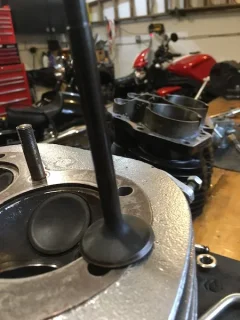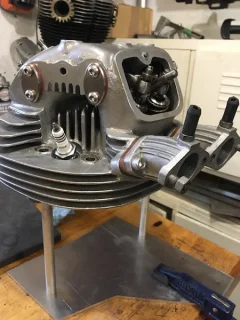HI Titon Thrasher. I looked [ googled ] up 1/ Cycling Proficiency Certificate, AND 2/ Pulteneytown Academy, 1966.
1/ LOOKS like it is to do with push bike safety ????
2/ Looks like it is what we call a primary school. ????
Never mind that though. Perhaps you can enlighten us about about the theory regarding the second ring gap that I have never heard about before.. Perhaps explain in better detail than that discussion above about the Science of second ring technology. It is a bit vague but I get what they are saying.
BTW, i did my training at Wellington Polytechnic and got my NZ Advance Trade Cert in the mid 1970's. I dealt with regular cars and light vehicles [ LOW REVERS ] and was never interested in racing.
I retired from the automotive field 19 years ago though and never had the need to update my qualifications.
Some info on bigger 2nd ring gaps cropped up on Britbike.com recently.
http://www.britbike.com/forums/ubbthreads.php/topics/772800/re-rings-to-oil-or-not-to-oil#Post772800
This link appears to be the source of it.
https://www.fordfe.com/ring-end-gap-input-please-t76170.html
A nice man called Barry says:
“Actually the big second gap process was defined from OEM research work at Federal-Mogul and Perfect Circle. As a result of the research, every OE I am aware of went from having a smaller second gap to having a larger second gap over a period of five years. Did not matter who - Ford, Chrysler, and GM all went that way.
The guy who worked for me at the time is likely to be one of the best ring guys on the planet, and he got them to run the same simulations (using F-M's Cray - not exactly a desktop dyno sort of deal) with input data from a then current Cup engine. He got similar positive results. We then tried it with a couple selected teams and went "public" with the info in a Jeff Smith article article in Chevy High Performance magazine, which was very well respected for tech at the time (mid-90s).
We had positive feedback on bigger second gaps from the OEMs as noted, as well as from numerous cCup and Pro Stock teams - essentially anybody who had the resources to do a controlled test with isolated variables so either no change or a positive one. Gap changes in an otherwise optimized package are going to be like that - incremental single digit or low,low double digit changes. Anybody that claims you'll get 30 or 40 horsepower from a gap only ring change is blowing smoke - or smoking something.
You'll get the biggest gains from ring stabilization at loads where pressures can approach equalization above and below the top ring. Part throttle operation or under bore distortion at high load. The more tightly sealed the top is, with the least distortion, the smaller the benefit. At some point other variables will outweigh most ability to verify any benefit in a street engine without A-B-A testing, but the trends are pretty clear.
Speed-Pro, Perfect Circle, JE (outsourced from NPR, Riken,F-M) and other ring providers have gone big 2nd gap on recommendations. Total Seal is the single exception to this. They cannot really promote the change since it goes against everything they've preached regarding the gapless deal for 20+ years. You will notice that subsequent to the big second gap deal they quickly moved to the topless top ring as a primary marketing piece and are comparatively quiet about the second.
Barry Rabotnick
Survivalmotorsports.com”


